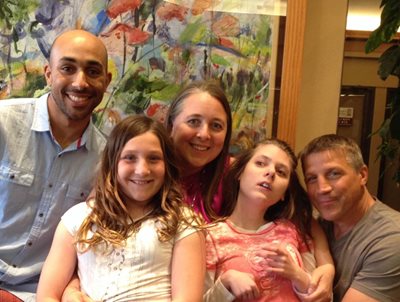Bailey - Alaska

I start our story by sharing the end. Bailey was alive for an incredibly beautiful 18 years until her unexpected and sudden death in July 2014 as her body gave up the fight against the challenges CMV presented to her.
There are pregnancies that begin with happiness, eager anticipation and delight….this was one of them. My husband and I were ready and this being our first child we learned all we could, went to every doctor’s appointment and were on top of what we needed to know in order to welcome this child into the world. We chose the best, most respected doctor in Anchorage and felt like we were experts by the end of the 9 months.
I was incredibly sick throughout my pregnancy but because I was considered well monitored we never suspected there was anything wrong with our baby. I was induced 10 days after my due date and Bailey was born weighing 5lbs. 1oz. and she needed oxygen right away. Within a day we were told she had a diaphragmatic eventration on her right side; her diaphragm wasn't working, it was elevated and crowding her lung, but doctors knew that wasn't enough to cause her to require as much oxygen as she needed. After putting Bailey through the TORCH test we were told her diagnosis was congenital cytomegalovirus (cCMV). We were completely unaware of what that meant. We’d never heard of CMV and it definitely wasn’t in any of the books or brochures we’d read or been given during my pregnancy. The neonatal doctor shared the full spectrum of possible long-term consequences for Bailey, including the fact that she already tested as profoundly deaf. If you spend 9 months thinking everything is fine and you hear the “full spectrum” list coming at you the only way I can describe it is horrifying. My first response was "I can't do this" but my husband grabbed my hand in a way that meant he knew differently.
I don’t know how I contracted CMV but doctors felt certain I contracted it during my first trimester. The strongest indicator for that opinion was a cat scan showing intracranial calcifications (calcium deposits) scattered throughout Bailey’s brain, like a spattering of snowballs in places where there should have been brain matter.
Bailey spent her first 3 months in the Neonatal Intensive Care Unit (NICU). She wouldn’t eat due to massive reflux and despite regular respiratory treatments she required high oxygen flow. Doctors indicated that the CMV was centralized in her lungs and they considered her to have CMV pneumonia. We were sent home right before Christmas, but Bailey wasn't ready and within the week she was back in NICU. Apparently it is rare to be discharged and readmitted into the NICU but the severity of Bailey's condition warranted the decision. At 4 months of age Bailey had a G-tube placed along with a fundoplication to prevent her suffering from chronic reflux.
After those initial months and her eventual discharge from the hospital, Bailey progressed very slowly despite her heavy routine of therapies: occupational, physical, oral feeding and communication/speech. Her oxygen requirement lessened and since about age 3 she used oxygen only at night and when she was ill. We reached far and wide for doctors who could provide the best treatment options for Bailey. Her spine slowly progressed into a severe case of scoliosis and as a result her right hip dislocated. As her scoliosis became worse she started to succumb to pneumonia as a result of her progressive scoliosis. Her first, and worst, case of pneumonia was October 2005; Bailey was 10 years old at the time. The intensity of that bout and the rapidness of its severity were horribly frightening to my husband and me. Her scoliosis progressed to 110° and at age 11 she went through a 10 hour surgery to have rods placed. Afterwards, Bailey recovered remarkably quickly from her illnesses and didn’t use oxygen more than a few times per year due to a cold or flu. It was a great relief to us to have our happy and loving little girl be as able as she could be and not suffer the hardships she endured before the surgery.
Bailey’s cognitive ability was difficult to measure; she was social without communicating, she loved without words and it was obvious when she didn’t like something as she threw it across a room or pushed it away, but she didn’t pretend she needed anything other than love from those around her. Bailey used a wheelchair, learned few signs (except to sign "swing" and "Mom"), had very poor circulation in her legs and feet, experienced tonic-clonic seizures several times a year, took all her nutrition through a g-tube, exhibited signs of pain, though we were never sure why, and had very limited use of her extremities.
Bailey never seemed to want more than what was at her fingertips. She made sure she got as much Mom-and-Dad-lap-time as humanly possible every day. When we put her arms around our necks she used every tiny muscle in her body to hold on as tight as she could. She loved swinging, swimming, skiing, flashy lights, fireworks, dog toys, horses and horse therapy and her heart embraced everyone who took the time to see her for the precious little girl that she was inside of that obstacle of a body she lived in.
So many nights I lay in bed next to her, my head resting against hers, listening to her small breaths while silently begging for her suffering to end; but not like this. Her pain, without her ever understanding why she went through such anguish and our grief is a terrible price to pay for a virus I should’ve known about and worked to prevent. In the end, in spite of it all Bailey lived an exceptional, beautiful and inspiring life.
--Shared by her mother, Karen